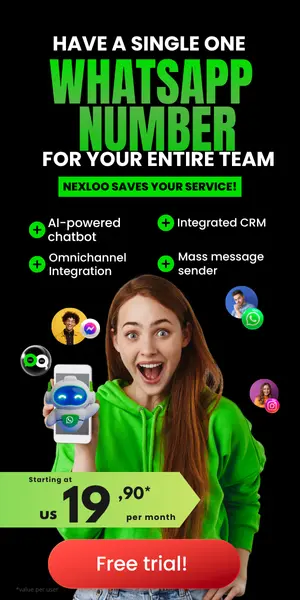In the rapidly evolving landscape of digital marketing, leveraging technology to enhance customer interactions has become paramount for businesses, especially small and medium enterprises. With the rise of chatbots, companies are constantly looking for innovative solutions that not only simplify operations but also engage customers effectively. Enter Typebot, a powerful tool designed to create interactive chatbots that offer seamless conversational experiences. As we delve deeper into Typebot, you’ll discover how it can transform your customer engagement while being user-friendly for those with limited technical expertise.
The beauty of Typebot lies in its ability to streamline business processes while enhancing marketing strategies. By automating conversations and providing quick responses, businesses can satisfy customer needs more efficiently than ever. Whether you’re a marketing professional or a business owner, understanding the nuances of Typebot can be a game-changer in driving conversions and building brand loyalty. Stay with us as we unpack the essential steps required to master Typebot and unlock its full potential.
This comprehensive guide will walk you through setting up and optimizing your Typebot experience, from account creation to the intricacies of designing effective chat flows. By the end of this article, you’ll not only appreciate the value of Typebot but also be equipped with the tools and knowledge to create captivating chatbots that resonate with your customers. Let’s embark on this journey to enhance your business operations through technology.
Getting Started with Typebot: Setting Up Your Account
Setting up your Typebot account is the first step toward creating engaging conversational experiences for your audience. The process is straightforward and user-friendly, making it accessible even for those who may not have extensive technical backgrounds. Start by visiting the Typebot website and clicking on the “Sign Up” button. You’ll be prompted to enter your email address and create a secure password. After submitting your information, be sure to confirm your email to activate your account properly.
Once your account is activated, log in to your Typebot dashboard. The dashboard is designed to provide you with a clear overview of your conversation flows, user interactions, and analytics. Familiarize yourself with the layout, as it offers easy navigation through various features. Typebot allows you to create multiple projects, so consider naming your initial project something descriptive, such as “Customer Engagement Flow” or “Lead Generation Bot.” This classification will help you manage your workflows and activities more effectively.
Next, explore the settings of your Typebot account, where you can customize preferences according to your business needs. This includes adjusting the default language, notification settings, and integrations with third-party tools such as CRMs and marketing platforms. It’s beneficial to take some time configuring these elements, as they will streamline your operations and enhance the functionality of your Typebot. Be on the lookout for any integration opportunities that could amplify your marketing and sales efforts.
After customizing your settings, it’s time to delve into creating your first flow. Typebot’s intuitive flow builder allows you to drag and drop various elements such as text blocks, buttons, and forms into your design. For optimal results, incorporate a mix of user input options and engaging content. Utilize tips and tricks available in the tutorial section of the Typebot site to design interactive and informative conversational pathways. The more you explore and experiment with the features available, the more adept you will become at crafting flows that resonate with your audience and drive meaningful interactions.
Understanding Flows: The Building Blocks of Typebot
Understanding flows is essential for harnessing the full functionality of Typebot, as they serve as the fundamental building blocks for automating interactions and enhancing user experience. At its core, a flow is a sequence of actions or decisions that your bot will follow based on user inputs, making it critical for both creating engaging conversations and achieving your business objectives. For small and medium businesses, mastering flows can significantly streamline operations and improve communication, making relationships with clients more accessible and personalized.
To create an effective flow in Typebot, start with defining clear goals. Identify the purpose of your bot and the desired outcomes for user interactions. Whether it’s generating leads, providing customer support, or disseminating information, having a focused objective will help shape the structure of your flow. Once you’ve established your goals, outline the expected user journey, mapping out the potential paths users might take based on their input, which will guide the design of your flow.
Next, utilize Typebot’s user-friendly interface to build your flow step by step. Begin by adding trigger points that initiate user interactions, such as keywords or buttons. From there, create branching options depending on user responses, which can include text responses, quick replies, or even multimedia elements. This variability allows you to create a rich conversational experience that keeps users engaged. Incorporate decision nodes to guide users based on their choices, ensuring that each interaction feels personalized and relevant.
Incorporating tips and tricks can further enhance the effectiveness of your flows. For instance, consider adding delay timers to simulate natural conversation pacing or incorporating fallback options to guide users back on track if they encounter confusion. Regularly testing your flow is also crucial; conduct simulations to observe how users interact and identify any potential friction points. This iterative approach allows you to optimize your flows continuously, ensuring they meet both user expectations and your business goals while making your Typebot implementation a true success.
Creating Your First Flow: Step-by-Step Guide
Creating your first flow in Typebot is a straightforward process that can significantly enhance your engagement with customers. To get started, access the Typebot platform and sign in. Once you are logged in, navigate to the dashboard, where you will see the option to create a new flow. Click on the “Create Flow” button, and you will be redirected to the flow designer interface. This is where the magic begins, as it allows you to visually construct your customer interaction pathways.
In the flow designer, you have the option to add various elements to your bot’s flow. Start by dragging and dropping the “Text” block onto the workspace. This block will serve as your initial message to users. Here, you can customize the text to suit the purpose of your flow. Make sure to use clear and concise language that aligns with your brand’s tone. Once you have added your message, it’s important to follow this with interactive options for user responses. You can add buttons, quick replies, or even inputs to guide conversations effectively.
After configuring your initial message and response options, it’s essential to establish logic in your flow. Utilize conditional blocks to define what happens when users respond in specific ways. For instance, if the user clicks on a particular button, it can trigger a different response or a follow-up question. This logical structure is crucial in guiding users seamlessly through the conversation. As you set this up, consider incorporating tips and tricks, such as branching paths to offer personalized experiences, keeping users engaged and encouraging them to reach their goal.
To finalize your flow, take advantage of the testing feature. This allows you to simulate interactions before going live. Check if all pathways function as expected and make adjustments as necessary. Once satisfied with the results, save your flow and publish it. By following these step-by-step instructions, your newly created Typebot flow will be ready to enhance user interactions, streamline customer engagement, and ultimately drive better results for your business.
Optimizing Your Typebot Flows for Maximum Impact
Optimizing your Typebot flows can significantly enhance user experience and improve overall effectiveness. To get started, focus on clearly defining your objectives. Whether your goal is to generate leads, provide customer support, or facilitate transactions, knowing your end goal will shape your flow design. Take the time to map out the user journey, identifying key touchpoints where interactions can occur. This helps create a seamless flow that guides users logically from one step to the next, ensuring clarity and engagement.
Another effective strategy for optimizing Typebot is to incorporate feedback loops within your flows. By regularly prompting users for feedback, you can gain valuable insights into their experiences and preferences. Use this information to refine your flows further. For instance, you can ask users if they found the information helpful or if they faced any challenges navigating through the bot. This data will enable you to make informed adjustments, enhancing the overall user experience and increasing the likelihood of achieving your flow objectives.
Utilizing conditional logic is another powerful tip for optimizing your Typebot flows. This feature allows you to create personalized experiences for users by tailoring responses based on their input. For example, if a user expresses interest in a specific product category, your Typebot can present options and information relevant to that choice. By implementing dynamic flows that respond to user preferences, you not only boost engagement but also increase the chances of conversions and satisfaction.
Lastly, leverage analytics to continuously monitor your Typebot flows’ performance. Analyzing user interaction data provides insights into where users drop off or spend the most time. This information is critical for iterative improvements. Regularly reviewing this data and A/B testing different flow variants can help identify what resonates best with your audience. By committing to an ongoing optimization process, you can create Typebot flows that not only meet user needs but also significantly enhance your business outcomes.
Integrating Typebot with Other Platforms for Enhanced Efficiency
Integrating Typebot with other platforms is essential for small and medium businesses looking to enhance their marketing and sales processes. By leveraging the capabilities of Typebot, organizations can streamline their workflows and create a more cohesive environment to interact with customers. One of the key practices is to ensure that Typebot can smoothly connect with existing tools, such as CRMs, email marketing platforms, and social media channels.
A strategic approach is to identify the platforms that are most relevant to your operational needs. Begin by reviewing the features of Typebot that complement those tools. For instance, integrating Typebot with a CRM can allow you to automatically gather customer data, which can assist in personalizing customer interactions and improving follow-up processes. Always ensure that your API keys and endpoints are correctly configured to facilitate seamless data transfer between systems.
Another best practice is to utilize webhooks effectively. Webhooks provide a way for Typebot and other applications to communicate in real-time. For example, if a customer engages with your chatbot, a webhook can trigger an action in your CRM, notifying your sales team immediately. This immediacy can significantly enhance your responsiveness and agility in dealing with customer inquiries. Additionally, keeping your webhooks organized and documented will ease troubleshooting and streamline updates as your workflows evolve.
It’s also beneficial to frequently evaluate the integrations and the performance of Typebot within your stack. Gathering feedback from your team and monitoring key performance indicators (KPIs) will help you identify what works well and what might need refining. Experimenting with new platforms and techniques, as well as staying updated on Typebot’s development and integration capabilities, can lead to innovative ways to enhance your processes further. Documenting every step in your integration process, including any challenges faced and how they were overcome, can be a valuable resource for your team and future projects.
Successful Typebot Implementations: Learning from Real-World Examples
Successful Typebot flows can significantly enhance the user experience and streamline operations for small and medium businesses. One real-world example involves a retail company that implemented Typebot to manage customer inquiries regarding product availability. By creating a flow that guides customers through common questions—such as checking stock levels, providing recommendations based on customer preferences, and facilitating order placements—the company was able to handle inquiries more efficiently. This not only improved response times but also led to a noticeable increase in customer satisfaction as shoppers could receive immediate answers without needing to speak to a representative.
Another effective case is a service-based business that utilized Typebot for appointment bookings. By setting up a flow that allows potential clients to select services, view availability, and book appointments directly through the bot, the business eliminated many manual scheduling tasks. This flow also included follow-up messages to confirm appointments and provide reminders, reducing no-show rates significantly. The automation of these processes not only saved time for the staff but also allowed the business to maximize its scheduling efficiency, leading to higher revenue through better utilization of resources.
Marketing campaigns have also benefited from Typebot implementations. A real estate agency created an engaging flow to assist users in searching for properties based on specific criteria such as location, price range, and number of bedrooms. By guiding users through a series of questions, the agency was able to capture leads effectively. The bot provided instant information on listings and scheduled viewings, streamlining the customer journey from inquiry to transaction. This not only increased the agency’s lead conversions but also provided users with a personalized experience, enhancing their overall satisfaction.
To get the most out of Typebot, businesses should consider best practices when designing their flows. It’s important to keep interactions clear and concise, using simple language to avoid confusion. Incorporating user feedback into flow designs can also help refine the experience over time, ensuring that customer needs are met effectively. By leveraging real-world examples and following these tips and tricks, businesses can create Typebot flows that not only meet their operational goals but also boost customer engagement and satisfaction.
Conclusion: Harnessing the Power of Typebot for Your Business
Mastering Typebot can be a game-changer for small and medium businesses, particularly in the realms of marketing and sales. As we conclude this guide, it’s essential to reflect on how effectively leveraging Typebot can lead to increased operational efficiency and enhanced customer engagement. With its user-friendly interface and powerful capabilities, Typebot stands out as an invaluable tool for streamlining communication and automating workflows.
To maximize the benefits of Typebot, consider integrating the various features discussed throughout this tutorial. Begin by customizing your flows to match the unique needs of your business. Utilize the various templates available for different use cases, ensuring that each interaction is meaningful and aligned with your marketing objectives. This personalized approach not only enhances customer experience but also makes your brand memorable.
When implementing Typebot, remember to continually refine your flows based on user interactions and feedback. Regularly monitoring analytics will provide insights into customer behavior, allowing you to optimize your communication strategies further. Experiment with different scripts and responses to see what resonates most with your audience. By adopting a test-and-learn mindset, you can fine-tune your Typebot setup to achieve better engagement rates and conversion success.
Finally, don’t overlook the value of sharing knowledge and techniques with your team. Providing training sessions on the tips and tricks learned in this guide will empower your staff to use Typebot effectively. A well-informed team can collaborate on improving customer interactions, ultimately driving sales and marketing strategies that are both innovative and results-oriented. By mastering Typebot, your business can establish a robust presence in the digital landscape, ensuring you stay ahead of the competition and meet the evolving needs of your customers.









